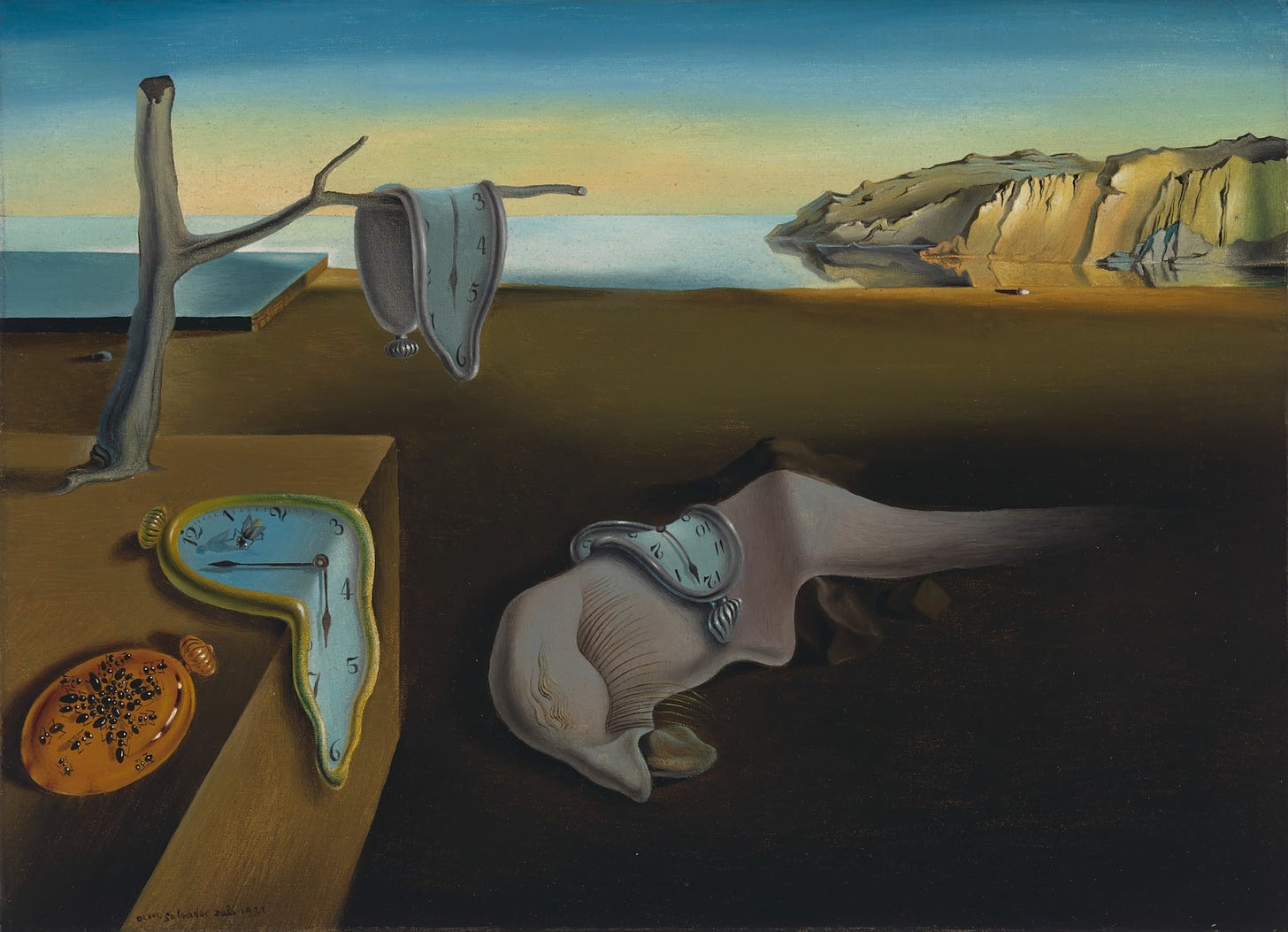Chasing Infinities
post by Michael Bateman (michael-bateman) · 2021-08-16T01:19:24.467Z · LW · GW · 1 commentsContents
An Abrupt Aside on Discount Rates Successively Wrecking the Earth Am I (Pascal’s) Mugging You? Pascal’s Wager Pascal’s Mugging Escaping Pascal Chasing Infinities None 1 comment
Crossposted from my blog Passing Time
How do we decide how to make decisions about the future?
How we, as a society, decide to answer this question is one of the most important moral quandaries we must face. All too often, questions of morality are focused on the actions themselves in question. The meta-question of how we make decisions across the dimension of time is, in my eyes, just as interesting as what is moral in the first place.
What exactly am I talking about here? Let’s run down an example: You’re given the choice between pressing two buttons: red and blue. The red button saves ten lives today; the blue button saves one million lives in 500 years. Which option should you choose?
An Abrupt Aside on Discount Rates
Discount rates describe the strength of time preferences; discount rates also, separately, describe opportunity costs. Mechanically, you discount future values by a discount rate in order to determine their present value to you today. Commonly, this idea is related to the time value of money; a dollar today is worth more than a dollar tomorrow. If I told you that you could give me $100 today and that I would give you $101 back in one year, you would probably pass on my offer. If so, your discount rate is higher than 1%. If you had a discount rate of zero, I could take your $100 now and you would happily accept $101 in a year (or two years, or ten years since you are not discounting the value of future returns as a function of time) since the proposition would have a positive net present value.
Discount rates are used extensively in business, finance, and public policy to guide decisions and are called, under various contexts, hurdle rates, required rates of return, or the weighted average cost of capital.
Due to my background, I’ve paid more attention to the types of discount rates related to investments, consumption, and goods—the opportunity cost of capital, the hurdle rate, internal rates of return, etc. I use these concepts every day at work, when I’m making personal financial decisions, and when reading about business, finance, or politics. These kinds of financial discount rates, however, are distinct from the (perhaps more interesting) pure rate of social time preference, which is what I will be referring to as a “time discount rate” or “time discounting.”

A time discount rate is the rate at which you value something today versus some time in the future based solely on the factor of time itself. Having a time discount rate of zero would mean you are indifferent to pleasure experienced today versus tomorrow; having a positive time discount rate means you prefer to experience pleasure today versus tomorrow; having a negative time discount rate means you prefer to experience pleasure tomorrow versus today.
We implicitly make use of time discount rates when making personal decisions surrounding health and money all of the time. Studies have shown that, given a choice, some people would pick a severe illness over a relatively mild one if the severe illness were to occur later in time. This behavior represents a discounting of future you and a placement of a premium on the present. Have you ever uttered the phrase, “that’s a problem for future me” when avoiding an unpleasant task? If so, you have a nonzero time discount rate.
Intuitively, this approach makes a lot of sense. After all, why wait for good things—of course I want to experience them sooner. When examined, however, it leads to some problems. Time discount rates have ethical consequences due to 1) future impacts to existing people (i.e., people who are alive now) 2) future impacts to future people (i.e., us in the future) 3) future impacts to future existing people (i.e., our descendants). Applying time discount rates to ethical questions has the consequence of valuing present people more than future people (and future existing people). This approach implies the life of a person born sooner has a higher intrinsic value than if they were born later or that an existing person has more moral value than a future person.
Let’s go back to our example again: Given two buttons, the red button (which saves ten lives today) and the blue button (which saves one million lives in 500 years), which option do you choose? Examine the implications of applying various discount rates to your choice:
Lives Saved Equivalence at Different Discount Rates

In the above chart, each discount rate implies indifference across the choices in a given row. In the case of holding a 5% discount rate, you would be indifferent between saving ten lives today or almost 34 lives in 25 years, or 1,315 lives in 100 years. As shown in the 500-year column, at large time horizons the numbers quickly balloon into huge figures; you are indeed reading it correctly that a 5% discount rate implies an indifference between saving one life today or more than 393 billion lives in 500 years.
It also follows that, at a 5% discount rate, if you were given the option of saving 392 billion lives in 500 years (one billion fewer lives than the implied indifference point of 393 billion lives) or ten lives today, you would be obligated to save the ten lives today since the present value of the 392 billion lives would only be equal to 9.97 lives after discounting.
This conclusion is not aligned with my intuitions. If I reject this conclusion, then I also have to reject the conclusions implied by the 1% time discount rate, or any nonzero discount rate.
It seems wrong to attach intrinsic value to the timing of peoples’ lives. Are we confident that placing intrinsic value on the time in which we were born is the right thing to do? Or should we instead take the approach of the 0% discount rate where we value lives equally, regardless of timing? More importantly, why does this actually matter? We don’t have buttons to press that save lives, do we?

Successively Wrecking the Earth
Though we can plausibly believe that we ought to give such lesser benefits to presently existing people, rather than giving greater benefits to other people, we should remember that, if we and many others often act in such ways, we and others may together make things go much worse. We might save some present people from harm rather than saving future people from some greater harms. Our successors might do the same, and their successors might do the same, thereby making the quality of future people’s lives lower, and lower, and lower. With such acts, we and our successors might together wreck the Earth.
Derek Parfit, Future People, the Non-Identity Problem, and Person-Affecting Principles
Although it sounds suspiciously categorical-imperative-y, Derek Parfit hints in the above passage at an intersection of time discounting and morality, public and economic policy, and business: climate change.
When making decisions regarding what to do about climate change, we are faced with a problem: the impacts of climate change are spread across both space and time. Impacts of climate change are felt both directly and indirectly all over the world, and these effects will be felt over periods of decades, centuries, and millennia. Thus, discount rates become extremely relevant when making policy choices now that will impact the future.
According to the 2018 report “Estimated Global Mortality from Present to 2100 from Climate Change”, a business-as-usual approach to climate change will lead to an estimated 106.5 million marginal deaths by 2100 from heat waves, wildfires, expanded tropical disease ranges, detrimental effects of heat on pregnancy, air pollution, reduced agricultural yields from heat and drought, reduction in marine food resources due to loss of coral reefs and fisheries, and increased natural disasters, among other issues.
As policymakers approach the question of climate change, they are faced with an array of potential investments (e.g., clean energy infrastructure, research, subsidizing electric vehicles) and returns on those investments (i.e., reductions in emissions). Policymakers use discount rates in this context to judge the value of reducing emissions by weighing investments now versus their future benefits.
There exist arguments for applying consumption-based or investment-based discount rates (such as suggested by the Ramsey Equation which adds a time preference to the product of the growth rate and the elasticity of marginal utility of consumption to calculate a “social discount rate”), but applying nonzero pure social time discount rates is difficult to justify. A 1% discount rate, applied to the estimated 106.5 million deaths, reduces the presently-valued lives by around 55% based on the rate of marginal deaths suggested in the paper.
Is discounting the value of future people that will be impacted by climate change just as fallacious as caring less about existing victims of climate change just because they are on the other side of the world, or failing to save a drowning child because it would slightly inconvenience us?
Other issues which invariably involve the concept of time discounting include nuclear energy (Is it unethical to expose future generations to thousands of years of risk surrounding radioactive waste?) and existential risks like nuclear holocaust, runaway nanotechnology or biotechnology, pandemics, and asteroid impacts, among other fun topics.
Am I (Pascal’s) Mugging You?
Pascal’s Wager
Pascal’s Wager is a famous piece of logic devised by Blaise Pascal in the 17th century. He reasoned the following:
If you believe in God and He is real, you get to enjoy Heaven forever. If you believe in God and He is not real, you were wrong but nothing happens.
If you don’t believe in God and He is real, you burn in Hell for eternity. If you don’t believe in God and He is not real, you were right but nothing happens.
Looking at the payoff functions, if you believe in God you will either get ∞ utility or 0 utility; if you don’t believe in God you will either get - ∞ utility or 0 utility. Therefore, the rational choice is to believe in God provided that the probability of God existing is nonzero since any nonzero probability p multiplied by ∞ is still ∞. Q.E.D.
Pascal’s Mugging
Pascal’s Mugging describes an extension of the logic of Pascal’s Wager. In this thought experiment a mugger asks Pascal for his wallet; in exchange, he says he will give Pascal double the cash in the wallet the next day. Pascal naturally says he does not believe the mugger. The mugger asks Pascal to assign a likelihood to the mugger carrying through on his end of the bargain; Pascal assigns a 1 in 1,000 odds. The mugger offers to give Pascal 2,000 times the amount in his wallet, prompting Pascal to again update his likelihood to be lower.
This continues, with Pascal confirming to the mugger "My Utility function is unbounded. And I deem two days of happy life twice as good as one such day; and 2,000 days twice as good as 1,000 days. I don’t believe in risk aversion or temporal discounting.” Thus, eventually, after the mugger offers an extra 1,000 quadrillion happy days of life in exchange for the wallet, Pascal, feeling rationally obligated, hands his wallet over, wondering aloud to the mugger about the curiosities of the mathematics of infinity.
The logic here is similar to Pascal’s Wager, but, unlike the more-famous wager, the Mugging does not require infinite values. Traditional utility-maximizers can be mugged using arbitrarily large, finite values.
Escaping Pascal
Inauthenticity and bad-faith considerations aside, it is surprisingly hard to logically refute Pascal’s Wager. Its trickiness stems from using infinite values with expected value calculations, since any nonzero probability p times ∞ is ∞. The St. Petersburg Paradox operates in a similar fashion.
Likewise, using traditional approaches to expected value make Pascal’s Mugging seem valid. Unless we alter the way we look at situations with low probability but high consequences we may find ourselves handing over our wallets.
As long as terms remain infinite, or utility functions unbounded, we might Wager or Mug ourselves into bad choices. Fortunately, we can escape from these undesirable conclusions by bounding our terms to finite values and bounding our utility functions. The concept of diminishing marginal returns, which states that as you have more of something each marginal unit provides less utility to you, provides a bounding mechanism.
Even Heaven itself would probably be subject to diminishing marginal returns as explored in Julian Barnes’ The Dream (seriously, read this short story. It is fantastic). Similarly, Camus remarked how “One must imagine Sisyphus happy” in his eternal toil; even endless punishment isn’t necessarily negative infinity utility. If we operate in the finite world, where marginal returns diminish, we can reject Pascal’s Wager.
To reject Pascal’s Mugging, which already is a bounded problem (i.e., it does not deal in infinities but rather arbitrarily large utilities), we have to take a different tact. In my eyes, the Sagan Standard can help us here: extraordinary claims require extraordinary evidence. Said another way, when Pascal was speaking to the mugger, the amount of evidence required to support the mugger’s claim should have grown at a faster rate than the claims themselves. Pascal’s incredulity, and thus the evidence required to convince him to hand over his wallet, should be so low at the point when the mugger is offering 1,000 quadrillion happy days of life that the expected value calculation should yield an expected amount less than the value of his wallet.

Chasing Infinities
Why did I bring up these thought experiments? My concern is that having a discount rate of zero will cause us to chase infinities. Actual infinities are pretty hard to come by when dealing in utilities, even when dealing in celestial time. With that said, after stars stop forming in 10^14 years, or more conservatively after the ~21 million more generations the Earth could support, while it may be impossible to continue life, the immense number of possible lives that could occur from now to that time are more than enough for us to Pascal’s Mug ourselves into ridiculous behavior.
Thus, while it does seem immoral to have arbitrary temporal preference, it also seems absurd to chase the infinities that the entire potential future history provides. As these are really finite numbers, chasing infinities is really meant here as a metaphor. Chasing an infinity symbol, ∞, will lead you in circles forever just as following the logic of expected utility applied to infinite values will lead you down a path to nowhere.
My position has updated in the course of discussions with friends and in doing the research to write this essay to accept a 0% pure rate of time preference as well as to realize the need to account for diminishing marginal returns. In the case of climate change, for instance, although we should not discount future lives purely because they occur in the future, it still may be reasonable to apply some small consumption-based discount rate if we believe that future people will have higher levels of consumption (or higher general quality of life) than we do now; just as $100 is more valuable to a minimum wage worker than Jeff Bezos, consumption now is relatively more valuable than in the future since there is less present consumption.
Sometimes innocuous things end up mattering a lot. In this essay, I’ve argued that the difference between zero and anything else matters a lot. I hope that policymakers will avoid the arbitrary immorality of time discounting when making decisions. The power of compound interest is too great; with just a 1% discount rate, the implied value of a life today would be worth almost 4.4 billion lives in 2,000 years. Imagine if philosophers from Antiquity 2,000 years ago were in favor of positive time discount rates. Again, from Derek Parfit:
Why should costs and benefits receive less weight, simply because they are further in the future? When the future comes, these benefits and costs will be no less real. Imagine finding out that you, having just reached your twenty-first birthday, must soon die of cancer because one evening Cleopatra wanted an extra helping of dessert. How could this be justified?
I don’t want to be Cleopatra. I use a time discount rate of zero.
Thanks to Tyler for getting me to read Future People, The Non-Identity Problem, and Person-Affecting Principles, Peter for his feedback, and Shreyas for more encouragement.
1 comments
Comments sorted by top scores.
comment by Zac Hatfield-Dodds (zac-hatfield-dodds) · 2021-08-16T02:01:41.360Z · LW(p) · GW(p)
I object to the notion of a pure rate of social time preference, on the basis that it's epiphenomenal. People and organisations do in fact have time preferences, but IMO they are far better explained by a combination of factors such as:
- Opportunity costs, especially compared to compounding returns on the earlier option
- Probability of payoff decreasing over time for a wide variety of reasons
- Preferences that are simply incoherent, i.e. violating VNM-rationality and subject to dutch-booking
I have never seen an example of pure-time-preference - outside of a thought experiment - which couldn't more naturally be explained in terms of impure time preference. For example:
- I would prefer a more severe disease (much) later, if I anticipate only a small chance of living that long
- I would prefer less money now to more later, if I don't trust you to deliver later
- I would prefer less money now to more later, if I can make more by investing the earlier payoff
- I would choose ten lives today over one million lives in 500 years because I don't believe the latter claim is credible